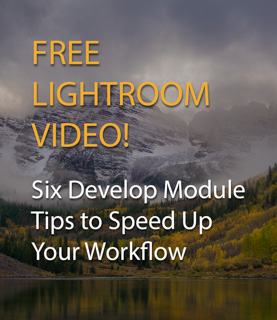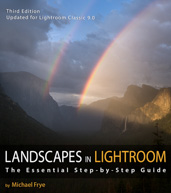by Michael Frye | Jun 30, 2011 | Photography Tips, Vision and Creativity
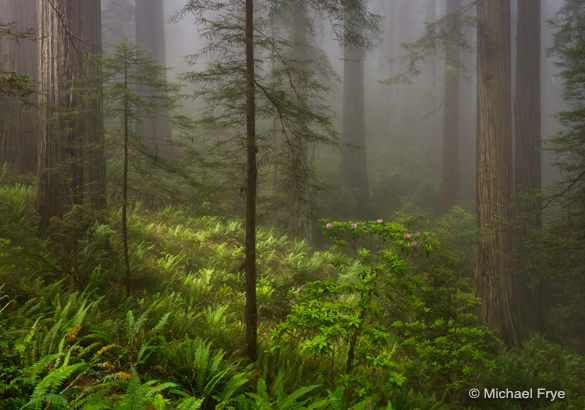
Redwoods, ferns, and rhododendrons near the northern California coast
Last week my wife Claudia and I visited our son Kevin in Arcata, California (he goes to Humboldt State University there). Arcata is just north of Eureka, along the northern coast of California, in redwood country.
Eleven years ago we’d camped in this area, and hiked a beautiful trail through the redwoods (nine-year-old Kevin complaining the whole way, especially on the steep climb back). The next morning I returned alone with my camera, found the forest enveloped in dense fog, and made one of my favorite photos ever.
I’d never gone back to that spot, but forecasters predicted patchy fog for last Wednesday morning, and it seemed like a good time to go. So we rose early and drove through fog, then sun, and back into fog. As we neared the trailhead I caught a glimpse of a roadside redwood grove that took my breath away. In the fog it was just so beautiful, so… primeval. I felt I’d traveled back in time a million years.
(more…)
by Michael Frye | Oct 25, 2010 | Vision and Creativity
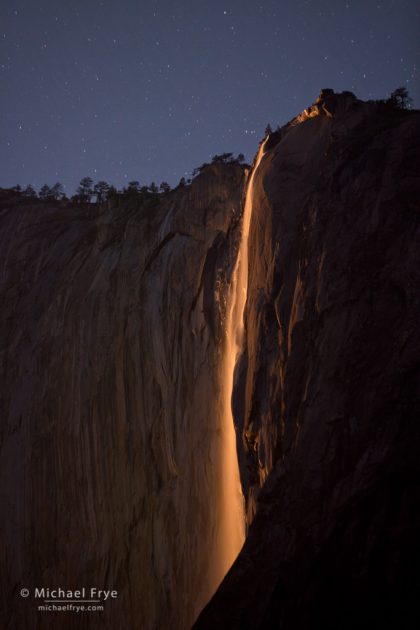
Horsetail Fall by moonlight, Yosemite NP, CA, USA
Horsetail Fall has become a celebrity, attracting more lenses than Brangelina. In February hundreds of photographers try to catch the fleeting sunset light on this little waterfall. Suitable vantage points are limited, so it’s hard to find new and different ways to portray this iconic subject. But it occurred to me that if I could catch the moon setting at just the right angle I might be able to photograph it at night.
It turns out that the right conditions for moonset light on Horsetail Fall are quite rare. The moon’s path varies greatly as it waxes and wanes. It has to set at the right angle while close to full (to provide enough light), before sunrise (so the dawn light doesn’t wash out sky), and there has to be water in the fall. Such conditions may occur only once every other year, at most.
Fortunately I found perfect conditions last spring. As I walked up to one of my favorite Horsetail Fall viewing locations at about 4 a.m., I saw an amazing sight: that beautiful, low-angle backlight on the waterfall, with the cliff behind it in the shade. It looked exactly like it does at sunset in February, only with stars in the sky above it.
Our eyes can’t see color in the dark, but cameras can, so as soon as I made my first test exposure I could see that now-classic orange glow on my LCD screen. I used both short and long shutter speeds, but ended up liking the short ones, with pinpoint stars, best.
This photograph was selected to be part of the Best of Nature show at the Ordover Gallery in the San Diego Natural History Museum. Two more of my images, Winter Sunrise From Tunnel View, and Winter Morning Along the Merced River, were also chosen. The opening reception is November 13th, 11 a.m. to 1 p.m., and will be on view until January 30, 2011. Hope to see some of you at the reception!
Speaking of Horsetail Fall, right now is it’s mirror season. The light is identical to February, and the only reason hundreds of photographers don’t try to photograph it in October is because there’s usually no water in the fall. But Yosemite Valley received almost four inches of rain in the last 48 hours, so there should be plenty of water in Horsetail Fall for the next day or two.
by Michael Frye | Sep 29, 2010 | Vision and Creativity
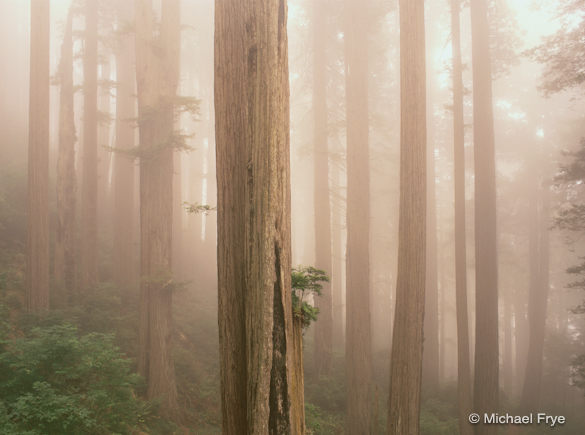
Redwoods in Fog, Del Norte State Park, California
Over the past months I’ve presented tutorials about some of the more technical sides of photography, like curves and camera calibration. These are important tools for realizing your vision, but today I want to turn in a different direction and talk about something less technical, but even more essential—inspiration.
Inspiration in photography can mean several different things. First, there’s the inspiration it takes to make a photograph—the leap of imagination that allows someone to capture a new, different way of seeing a subject, or create an original photographic concept.
Second, you can feel inspired when looking at a photograph. I’ve seen many images that have moved me in some way, perhaps by capturing a moment of great beauty, or a poignant interaction between people.
I’ve also felt inspired by a body of work and thought, “Wow, I want to do that! I want to make photographs that good.” In this case the inspiration is a motivator, something that spurs me to greater heights of creativity and imagination.
Many photographs and photographers have inspired me over the years. Seung Kye Lee lives in Norway, and might be the best landscape photographer you’ve never heard of. One of my favorite photographs of his, Rondane – Whispering Wind, has a great sense of space, depth, and scale—disorienting and surreal. Another favorite, Haiku, just portrays beautiful, magical light.
Next, for something completely different: Jerry Uelsmann. His dreamlike composite images—all done in the darkroom, by the way, not with Photoshop—are well known and widely collected. I had the privilege of meeting Jerry several times when he taught workshops for The Ansel Adams Gallery in the 1980s, and he is extremely nice and has a great sense of humor. He also has a large body of work from Yosemite, since he taught many workshops there. What I like about this image, Untitled, 1992, is the integration of human and natural forms. I wish we could all be this connected with nature.
I hope that some of my photographs might be inspiring to others. But I want to tell you today that everyone can do it. Yes, this means you. Your photographs can move people. Your photographs can inspire people.
How? By being inspired yourself. If you’re not moved by what you’re photographing, then your photographs won’t move others. But if you can see deeply into your subject, if you can feel a connection with a place, a moment, or a person, then you might find that spark of insight or imagination that can help you create a great image.
Ansel Adams said, “I have made thousands of photographs of the natural scene, but only those visualizations that were most intensely felt at the moment of exposure have survived the inevitable winnowing of time.” Ansel was more articulate with a camera than a typewriter, but he meant that his best photographs were made when he felt inspired by the scene in front of him.
That’s been my experience too. It was certainly the case when I made the photograph of redwoods at the top of this post. Walking among those giant trees on that foggy morning I felt awestruck, humbled, and deeply connected with everything around me.
It’s easy to get caught up in our jobs and our day-to-day existence. We think about money, or a difficult in-law, or the latest crisis in the news. I think that’s why we love photography. We can’t often express ourselves at work, but we can with a camera. Photography gives us a creative outlet, a way of keeping in touch with our true, inner selves, the person that often gets forgotten while sitting in meetings or paying the bills. A camera can help you connect, or re-connect, with the things that are really important to you. Find out what those things are, what things matter most to you in the world, and you can make inspiring photographs.
What subjects move you and inspire you? What photographs or photographers have you found inspirational? I’d like to hear your thoughts, and see links to images that have inspired you.
by Michael Frye | Sep 3, 2010 | Vision and Creativity
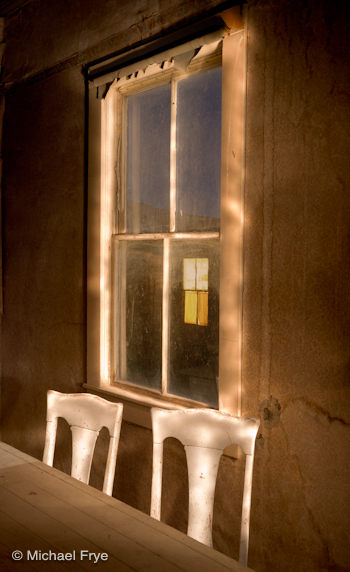
Miller house at night, Bodie State Park, CA, USA
I gave a short presentation to the workshop group in the afternoon, then we headed up to Bodie in the evening, arriving at dusk as the moon was rising. Being in Bodie at night was a great experience. It was a little spooky, but beautiful.
Night photography offers wonderful opportunities to be creative. The low light allows you to use long exposures to record movement, add your own light, or move objects during the exposure—including the camera.
Bodie, of course, has lots of great subjects for doing all these things, but at first I found it difficult to find the right subject and composition. When faced with a new situation it sometimes takes awhile to find your bearings. Eventually I found the composition shown here, in the often-photographed Miller House, and captured an image I’m reasonably happy with. I tried various techniques to light the chairs and interior. This version includes light from two different flashlights, as well as moonlight spilling in through the window, and a lamp illuminating a window in another building. (Some of the park staff actually live in Bodie, so this light came from one of the staff member’s houses.)
We had a great time, but it was too short—the permit lasted only four hours. I could easily have spent four nights there. I hope I’ll get a chance to go back some day.
Lance and Scott have a new book, called Night Photography: Finding Your Way in the Dark. It’s really well done, and I highly recommend it to anyone interested in night photography.





